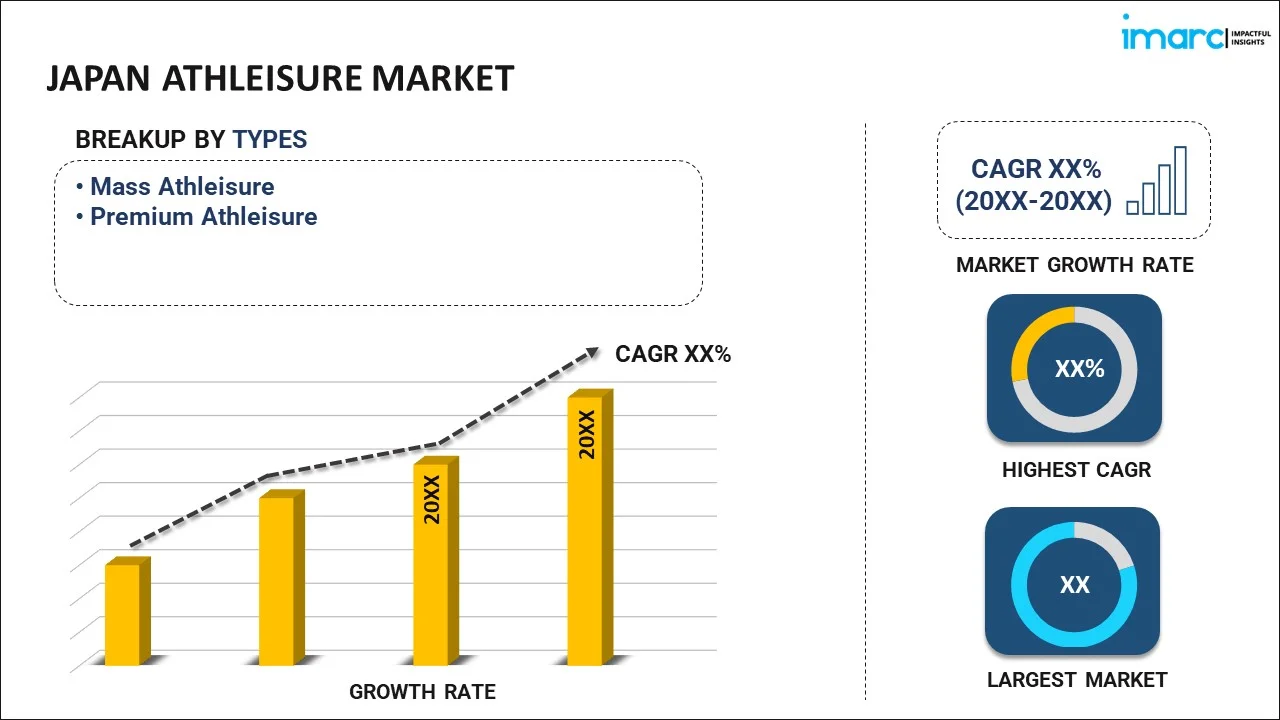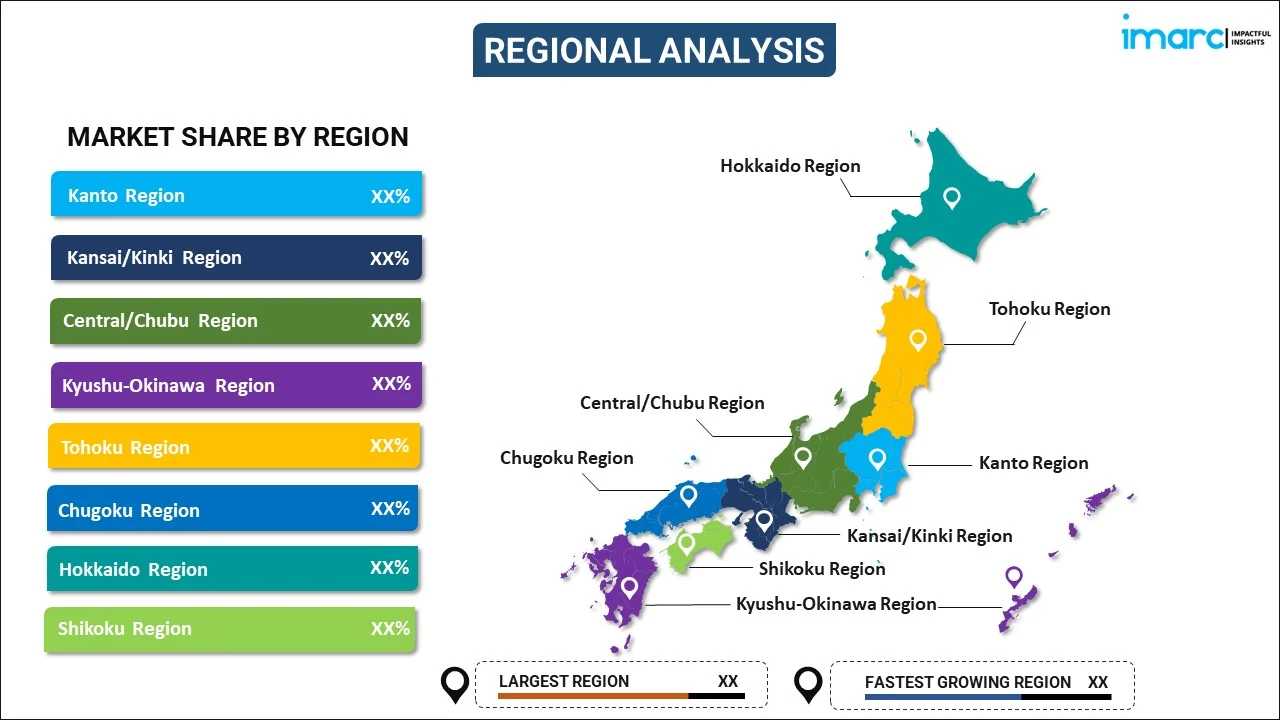
Japan Athleisure Market Report by Type (Mass Athleisure, Premium Athleisure), Product (Yoga Apparels, Shirts, Leggings, Shorts, and Others), Distribution Channel (Online, Offline), End User (Men, Women, Children), and Region 2025-2033
Market Overview:
Japan athleisure market size reached USD 23.8 Billion in 2024. Looking forward, IMARC Group expects the market to reach USD 38.1 Billion by 2033, exhibiting a growth rate (CAGR) of 5.4% during 2025-2033. The increasing focus on eco-friendly and sustainable fashion that has prompted athleisure brands to adopt more sustainable materials and practices, is primarily driving the market.
|
Report Attribute
|
Key Statistics
|
|---|---|
|
Base Year
|
2024
|
|
Forecast Years
|
2025-2033
|
|
Historical Years
|
2019-2024
|
|
Market Size in 2024
|
USD 23.8 Billion |
|
Market Forecast in 2033
|
USD 38.1 Billion |
| Market Growth Rate 2025-2033 | 5.4% |
Athleisure, a fusion of athletic and leisure, represents a contemporary fashion trend that has transcended gym walls to become a lifestyle choice for many. This style effortlessly marries the comfort and functionality of sportswear with the versatility and aesthetic appeal of casual clothing. Athleisure garments often include yoga pants, leggings, hoodies, sneakers, and other sporty attire, all designed to make a seamless transition from the gym to everyday life. One of the driving forces behind the popularity of athleisure is the growing emphasis on wellness and fitness in modern society. People now seek clothing that accommodates their active lifestyles while still keeping them fashionable and comfortable. Athleisure wear caters to this demand, offering a wide range of designs, colors, and fabrics to suit various preferences and occasions. Beyond its convenience and comfort, athleisure has also reshaped the fashion industry, leading to collaborations between sportswear brands and high-end designers.
Japan Athleisure Market Trends:
The athleisure market in Japan has witnessed remarkable growth in recent years owing to several key drivers. Firstly, the rise in health consciousness among consumers has been a pivotal factor propelling this trend. As people increasingly prioritize fitness and wellness, they seek comfortable yet stylish clothing that seamlessly transitions from the gym to daily life. Furthermore, the influence of social media and celebrities has played an important role in fueling the athleisure market's expansion. With influencers and celebrities frequently showcasing their athleisure outfits on various platforms, consumers are motivated to emulate these fashion-forward styles. Moreover, the emerging shift towards remote work and a more relaxed dress code have led to a greater demand for versatile and comfortable clothing, which athleisure perfectly embodies. Additionally, advancements in fabric technology, including innovations in moisture-wicking, antimicrobial, and stretch fabrics that have enhanced the functionality and appeal of athleisure wear, are expected to drive the athleisure market in Japan during the forecast period.
Japan Athleisure Market Segmentation:
IMARC Group provides an analysis of the key trends in each segment of the market, along with forecasts at the country level for 2025-2033. Our report has categorized the market based on type, product, distribution channel, and end user.
Type Insights:

- Mass Athleisure
- Premium Athleisure
The report has provided a detailed breakup and analysis of the market based on the type. This includes mass athleisure and premium athleisure.
Product Insights:
- Yoga Apparels
- Shirts
- Leggings
- Shorts
- Others
A detailed breakup and analysis of the market based on the product have also been provided in the report. This includes yoga apparels, shirts, leggings, shorts, and others.
Distribution Channel Insights:
- Online
- Offline
The report has provided a detailed breakup and analysis of the market based on the distribution channel. This includes online and offline.
End User Insights:
- Men
- Women
- Children
A detailed breakup and analysis of the market based on the end user have also been provided in the report. This includes men, women, and children.
Regional Insights:

- Kanto Region
- Kansai/Kinki Region
- Central/ Chubu Region
- Kyushu-Okinawa Region
- Tohoku Region
- Chugoku Region
- Hokkaido Region
- Shikoku Region
The report has also provided a comprehensive analysis of all the major regional markets, which include Kanto Region, Kansai/Kinki Region, Central/ Chubu Region, Kyushu-Okinawa Region, Tohoku Region, Chugoku Region, Hokkaido Region, and Shikoku Region.
Competitive Landscape:
The market research report has also provided a comprehensive analysis of the competitive landscape in the market. Competitive analysis such as market structure, key player positioning, top winning strategies, competitive dashboard, and company evaluation quadrant has been covered in the report. Also, detailed profiles of all major companies have been provided.
Japan Athleisure Market Report Coverage:
| Report Features | Details |
|---|---|
| Base Year of the Analysis | 2024 |
| Historical Period | 2019-2024 |
| Forecast Period | 2025-2033 |
| Units | Billion USD |
| Scope of the Report | Exploration of Historical Trends and Market Outlook, Industry Catalysts and Challenges, Segment-Wise Historical and Future Market Assessment:
|
| Types Covered | Mass Athleisure, Premium Athleisure |
| Products Covered | Yoga Apparels, Shirts, Leggings, Shorts, Others |
| Distribution Channels Covered | Online, Offline |
| End Users Covered | Men, Women, Children |
| Regions Covered | Kanto Region, Kansai/Kinki Region, Central/ Chubu Region, Kyushu-Okinawa Region, Tohoku Region, Chugoku Region, Hokkaido Region, Shikoku Region |
| Customization Scope | 10% Free Customization |
| Post-Sale Analyst Support | 10-12 Weeks |
| Delivery Format | PDF and Excel through Email (We can also provide the editable version of the report in PPT/Word format on special request) |
Key Questions Answered in This Report:
- How has the Japan athleisure market performed so far and how will it perform in the coming years?
- What has been the impact of COVID-19 on the Japan athleisure market?
- What is the breakup of the Japan athleisure market on the basis of type?
- What is the breakup of the Japan athleisure market on the basis of product?
- What is the breakup of the Japan athleisure market on the basis of distribution channel?
- What is the breakup of the Japan athleisure market on the basis of end user?
- What are the various stages in the value chain of the Japan athleisure market?
- What are the key driving factors and challenges in the Japan athleisure?
- What is the structure of the Japan athleisure market and who are the key players?
- What is the degree of competition in the Japan athleisure market?
Key Benefits for Stakeholders:
- IMARC’s industry report offers a comprehensive quantitative analysis of various market segments, historical and current market trends, market forecasts, and dynamics of the Japan athleisure market from 2019-2033.
- The research report provides the latest information on the market drivers, challenges, and opportunities in the Japan athleisure market.
- Porter's five forces analysis assist stakeholders in assessing the impact of new entrants, competitive rivalry, supplier power, buyer power, and the threat of substitution. It helps stakeholders to analyze the level of competition within the Japan athleisure industry and its attractiveness.
- Competitive landscape allows stakeholders to understand their competitive environment and provides an insight into the current positions of key players in the market.
Need more help?
- Speak to our experienced analysts for insights on the current market scenarios.
- Include additional segments and countries to customize the report as per your requirement.
- Gain an unparalleled competitive advantage in your domain by understanding how to utilize the report and positively impacting your operations and revenue.
- For further assistance, please connect with our analysts.
 Inquire Before Buying
Inquire Before Buying
 Speak to an Analyst
Speak to an Analyst
 Request Brochure
Request Brochure
 Request Customization
Request Customization




.webp)




.webp)












